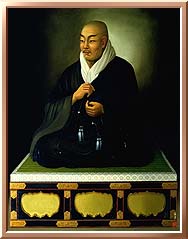 |
Shinran
Shonin |
Shinran Shonin (1173-1262 CE) was born into an aristocractic family. Orphaned at the age of nine, he entered the Tendai temple on Mt Hiei, where he spent twenty years in monastic life. His later works show extensive familiarity with Buddhist writings, suggesting that he exerted great effort in his studies. He also was known for performing such practices as the recitation of the nembutsu (see Honen Memorial Day) for prolonged periods of time.
However, after twenty years he despaired of ever attaining awakening through such discipline and study. He was also discouraged by the deep corruption that afflicted the monastery, and when he was twenty-nine, he went on a long retreat at a temple in Kyoto. On the ninety-fifth day of the retreat, he had a dream that he later interpreted as an indication that he should seek out Honen Shonin.
Honen had himself left the Tendai temple to teach a radically new understanding of religious practice. Declaring that all self-generated efforts toward enlightenment were tainted by attachments and therefore meaningless, he taught the simple repetition of the nembutsu—not as a contemplative exercise but rather as a means of surrendering to the grace of Amida Buddha.
After months of listening to Honen teach, Shinran abandoned his Tendai practices to join Honen’s movement. Soon, the established temples grew jealous of Honen’s following, and in 1207 CE they succeeded in gaining a government ban on his teaching. Several of his followers were executed, and Honen and others, including Shinran, were banished from the capital. Stripped of his priesthood, and exiled to the coast, Shinran subsequently married and began raising a family. Declaring himself “neither monk nor layman,” he chose for himself the name Gutoku, ‘foolish/shaven,’ indicating the futility of attachment to one’s own intellect and goodness.
He was pardoned after five years, but decided not to return to Kyoto. Instead, in 1214, at the age of forty-two, he made his way into the Kanto region, where he spread the nembutsu teaching for twenty years, building a large movement among the peasants and lower samurai.
In his sixties, he returned to Kyoto to devote his final three decades to writing. Supported by gifts from his followers, he lived with relatives, neither giving sermons nor teaching disciples. He completed his major work, popularly known as Kyogyoshinsho, “teaching, practise, faith, and attainment”, and composed hundreds of hymns in which he rendered the Chinese scriptures accessible to ordinary people. He continued to be creative for the rest of his life, dying at the age of ninety.